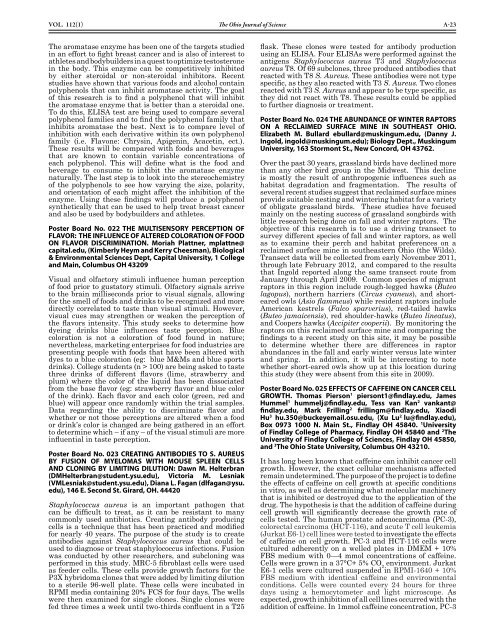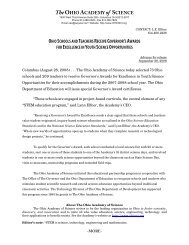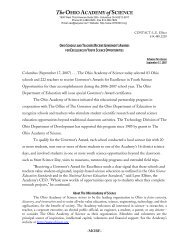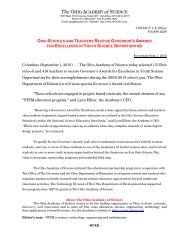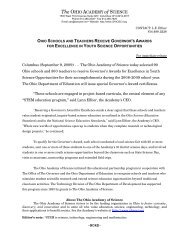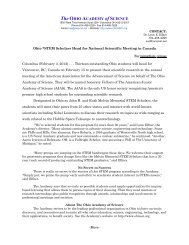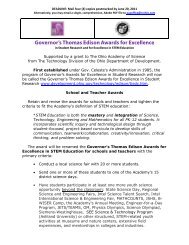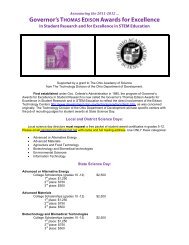The Ohio Journal of - The Ohio Academy of Science
The Ohio Journal of - The Ohio Academy of Science
The Ohio Journal of - The Ohio Academy of Science
You also want an ePaper? Increase the reach of your titles
YUMPU automatically turns print PDFs into web optimized ePapers that Google loves.
Vol. 112(1)<br />
<strong>The</strong> aromatase enzyme has been one <strong>of</strong> the targets studied<br />
in an effort to fight breast cancer and is also <strong>of</strong> interest to<br />
athletes and bodybuilders in a quest to optimize testosterone<br />
in the body. This enzyme can be competitively inhibited<br />
by either steroidal or non-steroidal inhibitors. Recent<br />
studies have shown that various foods and alcohol contain<br />
polyphenols that can inhibit aromatase activity. <strong>The</strong> goal<br />
<strong>of</strong> this research is to find a polyphenol that will inhibit<br />
the aromatase enzyme that is better than a steroidal one.<br />
To do this, ELISA test are being used to compare several<br />
polyphenol families and to find the polyphenol family that<br />
inhibits aromatase the best. Next is to compare level <strong>of</strong><br />
inhibition with each derivative within its own polyphenol<br />
family (i.e. Flavone: Chrysin, Apigenin, Acacetin, ect.).<br />
<strong>The</strong>se results will be compared with foods and beverages<br />
that are known to contain variable concentrations <strong>of</strong><br />
each polyphenol. This will define what is the food and<br />
beverage to consume to inhibit the aromatase enzyme<br />
naturally. <strong>The</strong> last step is to look into the stereochemistry<br />
<strong>of</strong> the polyphenols to see how varying the size, polarity,<br />
and orientation <strong>of</strong> each might affect the inhibition <strong>of</strong> the<br />
enzyme. Using these findings will produce a polyphenol<br />
synthetically that can be used to help treat breast cancer<br />
and also be used by bodybuilders and athletes.<br />
Poster Board No. 022 THE MULTISENSORY PERCEPTION OF<br />
FLAVOR: THE INFLUENCE OF ALTERED COLORATION OF FOOD<br />
ON FLAVOR DISCRIMINATION. Moriah Plattner, mplattne@<br />
capital.edu, (Kimberly Heym and Kerry Cheesman), Biological<br />
& Environmental <strong>Science</strong>s Dept, Capital University, 1 College<br />
and Main, Columbus OH 43209<br />
Visual and olfactory stimuli influence human perception<br />
<strong>of</strong> food prior to gustatory stimuli. Olfactory signals arrive<br />
to the brain milliseconds prior to visual signals, allowing<br />
for the smell <strong>of</strong> foods and drinks to be recognized and more<br />
directly correlated to taste than visual stimuli. However,<br />
visual cues may strengthen or weaken the perception <strong>of</strong><br />
the flavors intensity. This study seeks to determine how<br />
dyeing drinks blue influences taste perception. Blue<br />
coloration is not a coloration <strong>of</strong> food found in nature;<br />
nevertheless, marketing enterprises for food industries are<br />
presenting people with foods that have been altered with<br />
dyes to a blue coloration (eg: blue M&Ms and blue sports<br />
drinks). College students (n > 100) are being asked to taste<br />
three drinks <strong>of</strong> different flavors (lime, strawberry and<br />
plum) where the color <strong>of</strong> the liquid has been dissociated<br />
from the base flavor (eg: strawberry flavor and blue color<br />
<strong>of</strong> the drink). Each flavor and each color (green, red and<br />
blue) will appear once randomly within the trial samples.<br />
Data regarding the ability to discriminate flavor and<br />
whether or not those perceptions are altered when a food<br />
or drink’s color is changed are being gathered in an effort<br />
to determine which – if any – <strong>of</strong> the visual stimuli are more<br />
influential in taste perception.<br />
Poster Board No. 023 CREATING ANTIBODIES TO S. AUREUS<br />
BY FUSION OF MYELOMAS WITH MOUSE SPLEEN CELLS<br />
AND CLONING BY LIMITING DILUTION: Dawn M. Helterbran<br />
(DMHelterbran@student.ysu.edu), Victoria M. Lesniak<br />
(VMLesniak@student.ysu.edu), Diana L. Fagan (dlfagan@ysu.<br />
edu), 146 E. Second St. Girard, OH. 44420<br />
Staphylococcus aureus is an important pathogen that<br />
can be difficult to treat, as it can be resistant to many<br />
commonly used antibiotics. Creating antibody producing<br />
cells is a technique that has been practiced and modified<br />
for nearly 40 years. <strong>The</strong> purpose <strong>of</strong> the study is to create<br />
antibodies against Staphylococcus aureus that could be<br />
used to diagnose or treat staphylococcus infections. Fusion<br />
was conducted by other researchers, and subcloning was<br />
performed in this study. MRC-5 fibroblast cells were used<br />
as feeder cells. <strong>The</strong>se cells provide growth factors for the<br />
P3X hybridoma clones that were added by limiting dilution<br />
to a sterile 96-well plate. <strong>The</strong>se cells were incubated in<br />
RPMI media containing 20% FCS for four days. <strong>The</strong> wells<br />
were then examined for single clones. Single clones were<br />
fed three times a week until two-thirds confluent in a T25<br />
<strong>The</strong> <strong>Ohio</strong> <strong>Journal</strong> <strong>of</strong> <strong>Science</strong> A-23<br />
flask. <strong>The</strong>se clones were tested for antibody production<br />
using an ELISA. Four ELISAs were performed against the<br />
antigens Staphylococcus aureus T3 and Staphylococcus<br />
aureus T8. Of 69 subclones, three produced antibodies that<br />
reacted with T8 S. Aureus. <strong>The</strong>se antibodies were not type<br />
specific, as they also reacted with T3 S. Aureus. Two clones<br />
reacted with T3 S. Aureus and appear to be type specific, as<br />
they did not react with T8. <strong>The</strong>se results could be applied<br />
to further diagnosis or treatment.<br />
Poster Board No. 024 THE ABUNDANCE OF WINTER RAPTORS<br />
ON A RECLAIMED SURFACE MINE IN SOUTHEAST OHIO.<br />
Elizabeth M. Bullard ebullard@muskingum.edu, (Danny J.<br />
Ingold, ingold@muskingum.edu); Biology Dept., Muskingum<br />
University, 163 Stormont St., New Concord, OH 43762.<br />
Over the past 30 years, grassland birds have declined more<br />
than any other bird group in the Midwest. This decline<br />
is mostly the result <strong>of</strong> anthropogenic influences such as<br />
habitat degradation and fragmentation. <strong>The</strong> results <strong>of</strong><br />
several recent studies suggest that reclaimed surface mines<br />
provide suitable nesting and wintering habitat for a variety<br />
<strong>of</strong> obligate grassland birds. <strong>The</strong>se studies have focused<br />
mainly on the nesting success <strong>of</strong> grassland songbirds with<br />
little research being done on fall and winter raptors. <strong>The</strong><br />
objective <strong>of</strong> this research is to use a driving transect to<br />
survey different species <strong>of</strong> fall and winter raptors, as well<br />
as to examine their perch and habitat preferences on a<br />
reclaimed surface mine in southeastern <strong>Ohio</strong> (the Wilds).<br />
Transect data will be collected from early November 2011,<br />
through late February 2012, and compared to the results<br />
that Ingold reported along the same transect route from<br />
January through April 2009. Common species <strong>of</strong> migrant<br />
raptors in this region include rough-legged hawks (Buteo<br />
lagopus), northern harriers (Circus cyaneus), and shorteared<br />
owls (Asio flammeus) while resident raptors include<br />
American kestrels (Falco sparverius), red-tailed hawks<br />
(Buteo jamaicensis), red shoulder-hawks (Buteo lineatus),<br />
and Coopers hawks (Accipiter cooperii). By monitoring the<br />
raptors on this reclaimed surface mine and comparing the<br />
findings to a recent study on this site, it may be possible<br />
to determine whether there are differences in raptor<br />
abundances in the fall and early winter versus late winter<br />
and spring. In addition, it will be interesting to note<br />
whether short-eared owls show up at this location during<br />
this study (they were absent from this site in 2009).<br />
Poster Board No. 025 EFFECTS OF CAFFEINE ON CANCER CELL<br />
GROWTH. Thomas Pierson 1 piersont1@findlay.edu, James<br />
Hummel 1 hummelj@findlay.edu, Tess van Kan 2 vankant@<br />
findlay.edu, Mark Frilling 2 frillingm@findlay.edu, Xiaodi<br />
Hu 3 hu.350@buckeyemail.osu.edu, (Xu Lu 2 lu@findlay.edu),<br />
Box 0973 1000 N. Main St., Findlay OH 45840. 1 University<br />
<strong>of</strong> Findlay College <strong>of</strong> Pharmacy, Findlay OH 45840 and 2 <strong>The</strong><br />
University <strong>of</strong> Findlay College <strong>of</strong> <strong>Science</strong>s, Findlay OH 45850,<br />
and 3 <strong>The</strong> <strong>Ohio</strong> State University, Columbus OH 43210.<br />
It has long been known that caffeine can inhibit cancer cell<br />
growth. However, the exact cellular mechanisms affected<br />
remain undetermined. <strong>The</strong> purpose <strong>of</strong> the project is to define<br />
the effects <strong>of</strong> caffeine on cell growth at specific conditions<br />
in vitro, as well as determining what molecular machinery<br />
that is inhibited or destroyed due to the application <strong>of</strong> the<br />
drug. <strong>The</strong> hypothesis is that the addition <strong>of</strong> caffeine during<br />
cell growth will significantly decrease the growth rate <strong>of</strong><br />
cells tested. <strong>The</strong> human prostate adenocarcinoma (PC-3),<br />
colorectal carcinoma (HCT-116), and acute T cell leukemia<br />
(Jurkat E6-1) cell lines were tested to investigate the effects<br />
<strong>of</strong> caffeine on cell growth. PC-3 and HCT-116 cells were<br />
cultured adherently on a welled plates in DMEM + 10%<br />
FBS medium with 0—4 mmol concentrations <strong>of</strong> caffeine.<br />
Cells were grown in a 37°C+ 5% CO 2 environment. Jurkat<br />
E6-1 cells were cultured suspended in RPMI-1640 + 10%<br />
FBS medium with identical caffeine and environmental<br />
conditions. Cells were counted every 24 hours for three<br />
days using a hemocytometer and light microscope. As<br />
expected, growth inhibition <strong>of</strong> all cell lines occurred with the<br />
addition <strong>of</strong> caffeine. In 1mmol caffeine concentration, PC-3


